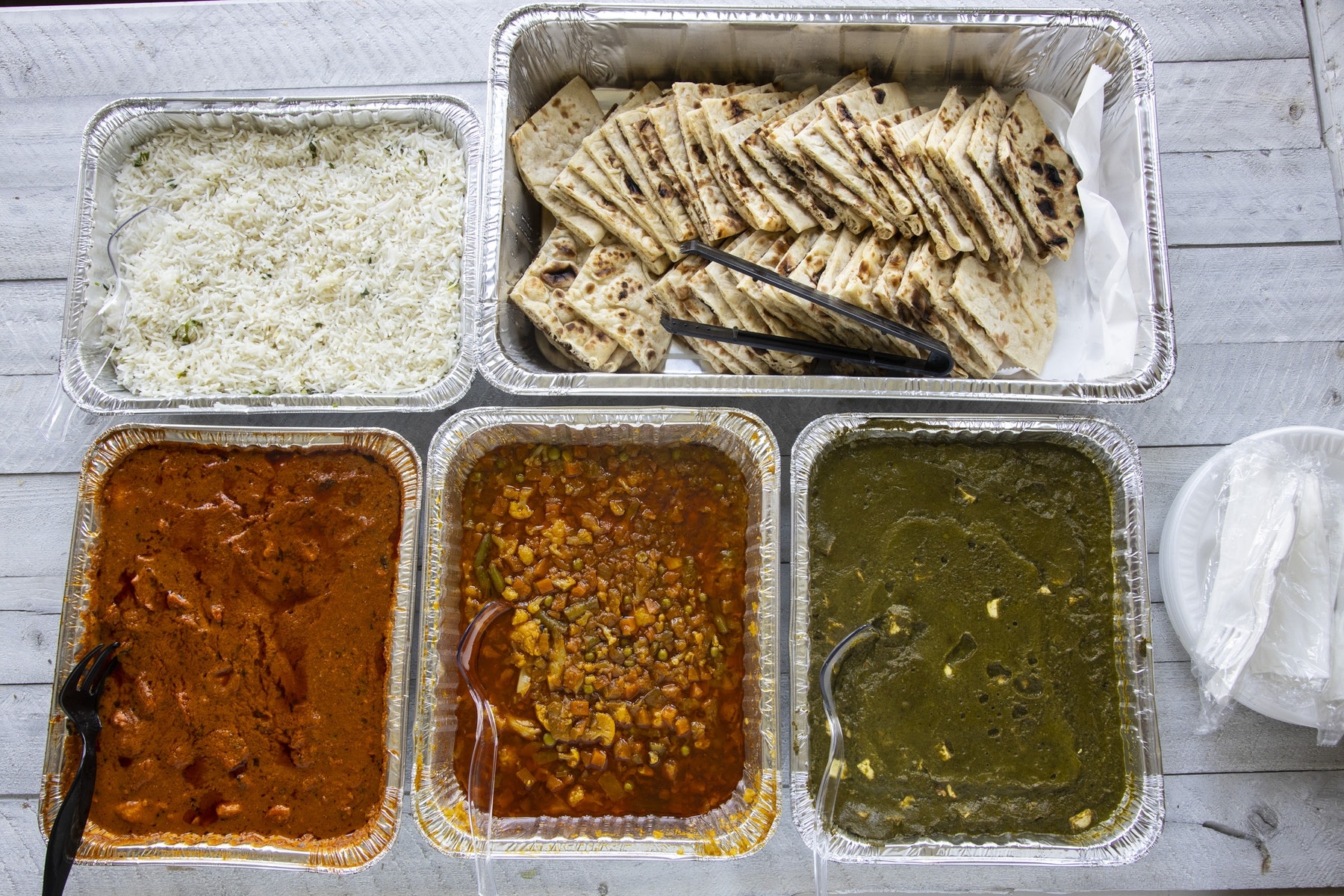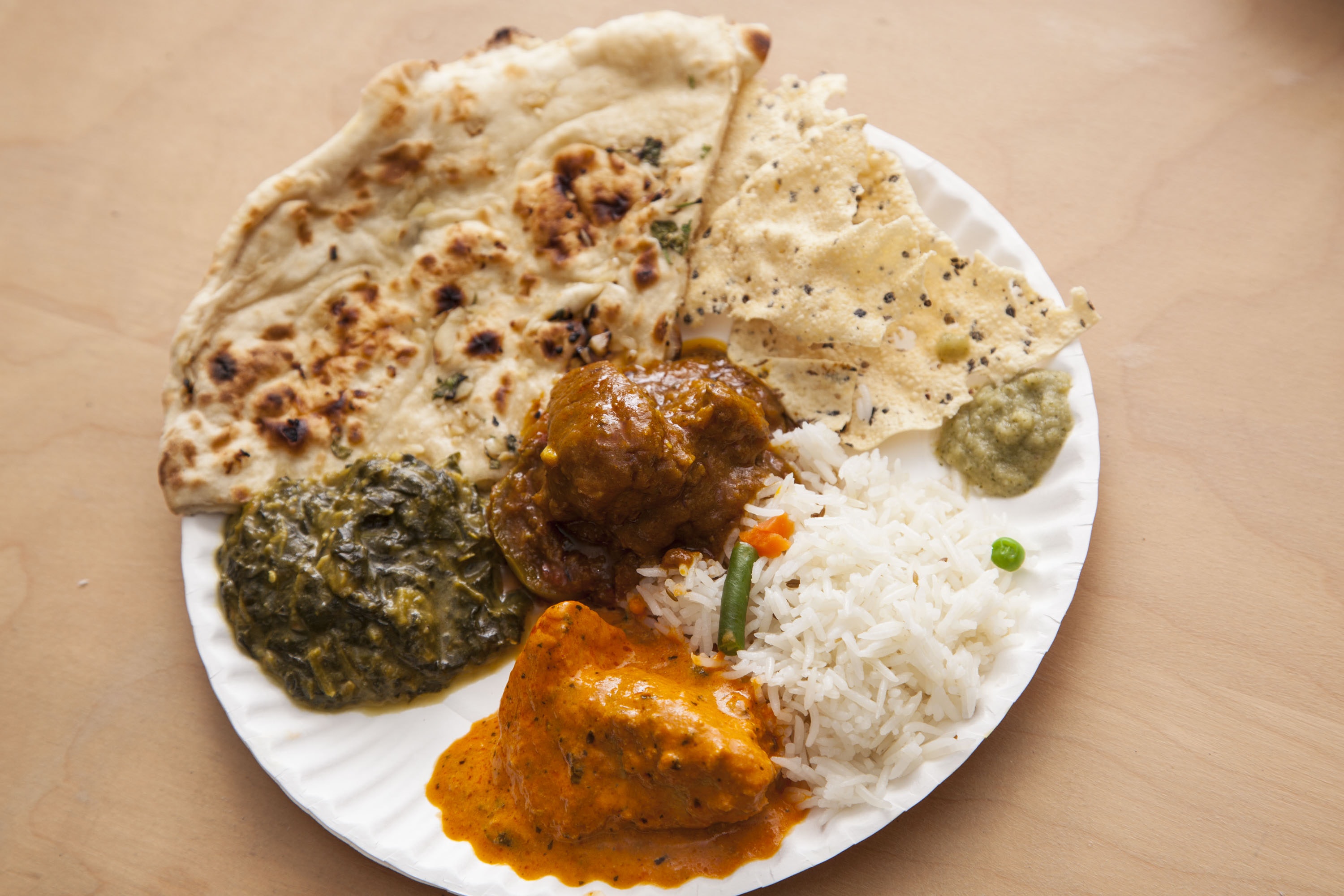Indian Buffet Catering
The history of Indian cuisine dates back over 5,000 years. Throughout the centuries, Indian food has been influenced by various cultures, including Mongolian, Persian, and Chinese cuisines. The common thread that runs through all of these influences is the distinct mixture of spices that gives Indian cuisine its flavor and aroma. Indian ingredients are as varied as the people themselves, and the available foods vary depending on region. Certain dishes use specific spice blends, known as masala. For instance, biryani masala—which is made up of cardamom, cinnamon, cloves and fennel—is used for biryani, an oven-cooked dish of rice and a vegetable, seafood, or meat. Oftentimes, Indian cuisine is associated with being “spicy” but that is not always the case. These blends of spices enhance the sweet and savory dishes they are added to rather than just bringing the heat. From butter chicken and lamb vindaloo to saag paneer and chana masala, Indian cuisine features a great blend of dishes for meat-eaters, vegetarians, and vegans alike. Your team will love the bevy of options available to them!
Our Menus

Best Practices and Tips when Ordering Indian Buffet
If you're new to Indian cuisine, some of the most popular dishes are typically chicken tikka masala, butter chicken, chicken korma, and lamb vindaloo for meat-eaters. The most popular vegetarian option is usually saag paneer (spinach and cheese), while the most popular vegan dish is typically aloo gobi (potato and cauliflower) or chana masala (chickpeas in masala sauce). However, it's important to make sure that none of your colleagues are overly sensitive to certain aromas, as Indian food can have a distinct scent that can take over small spaces.

Be Sure to Order Enough!
We always recommend ordering extra food for buffets, as people often take more than their fair share. Typically, 10-20% higher than your headcount will suffice. Proteins especially can be cut inconsistently, leading to some guests getting larger portions than others. Additionally, it's a good idea to order more buffet-style sides than you think you need. Everyone’s definition of a "full portion" can vary widely.
Can I Order an Indian Buffet for my Gluten-Free Guests?
Absolutely! Indian cuisine has many options for gluten-free guests but you'll want to avoid over-ordering naan or fried appetizers such as samosas. If you'd like to know if a dish is gluten-free, just look for the (GF) indicator next to the item.
Frequently Asked Questions
What goes well with Indian Buffets?
Popular sides for Indian buffets are samosas (typically vegan) and pakoras (typically, vegan and gluten-free due to the use of chickpea flour!). For dessert, try kheer, a traditional rice pudding made with basmati rice, milk, sugar, cardamom, and raisins.
How close should I plan my delivery time to my eat time?
Luckily, Indian cuisine doesn't feature a mixture of hot and cold items that can sometimes cause dishes to become lukewarm. However, as with any buffet style meal that travels in aluminum trays, condensation can affect certain items such as samosas and naan. We recommend planning your eat time no more than 15 or 20 minutes after delivery.
Are there vegetarian and vegan options for Indian buffets?
Yes! Indian cuisine is filled with vegetarian and vegan dishes that are sure to make all of your vegetarian and vegan guests happy. Hearty curries and rice dishes are loaded with vegetables and spices making them an exciting alternative to just another boring salad option.
What ingredients are in Indian Buffet?
Meat Entrees
- Akbari Murgh
- Beef Boti Tikka Masala
- Beef Curry
- Beef Mushroom Bhuda
- Beef Saag
- Beef Vindaloo
- Butter Chicken
- Chicken Chili
- Chicken Curry
- Chicken Daal
- Chicken Kadai
- Chicken Keema Matar
- Chicken Korma
- Chicken Mughlai
- Chicken Munchurian
- Chicken Mushroom
- Chicken Mushroom Balti
- Chicken Saag
- Chicken Saagwala
- Chicken Spinach
- Chicken Tariwala
- Chicken Thai Green Curry
- Chicken Tikka
- Chicken Tikka Masala
- Chicken Tikka Saag
- Chicken Tilla Jalfrezi
- Chicken Vindaloo
- Coconut Chicken
- Coconut Chicken Curry
- Coconut Lamb Curry
- Goa Chicken Vindaloo
- Goa Lamb Vindaloo
- Goan Fish Curry
- Goan Shrimp Curry
- Goat Curry
- Himalayan Quinoa Biryani
- Jhinga Rasmisla
- Kadai Chicken
- Kadai Lamb
- Kadhai Chicken
- Kashmiri Gosht
- Lamb Bhuna
- Lamb Curry
- Lamb Korma
- Lamb Mushroom
- Lamb Rogan Josh
- Lamb Saag
- Lamb Spinach
- Lamb Tikka
- Lamb Vindaloo
- Macher Jhol
- Murgh Makhni
- Nepalese Gurkha Chicken Curry
- Punjabi Lamb Saag
- Saar Special
- Salmon Curry
- Salmon Vindaloo
- Shrimp Bhuna
- Shrimp Curry
Vegetable Entrees
- Aloo Baigan
- Aloo Baingain
- Aloo Bhanta
- Aloo Cauli
- Aloo Cauli Ko Tarkari
- Aloo Ghobi
- Aloo Gobhi
- Aloo Gobi
- Aloo Gohbi
- Aloo Matar
- Aloo Palak
- Aloo Simla Mirch
- Bagan Bharta
- Baigan Bhartha
- Baingain Bhartha
- Baingan Bharta
- Baingan Bhartha
- Bengan Bharta
- Bhindi Do Pyaza
- Bhindi Karahi
- Bhindi Masala
- BNG Paneer Curry
- Chana Chaat Masala
- Chana Dal
- Chana Masala
- Channa Masala
- Coconut Vegetable Curry
- Daal Makhani
- Daal Saag
- Dal Makhani
- Dal Makhni
- Dal Tadka
- Dhaba Dal
- Ginger Eggplant with Vatana
- Gobi Aloo
- Jeera Aloo
- Kadai Bhindi Masala
- Kala Channa
- Karahi Paneer
- Lasooni Saag Paneer
- Malai Kofta
- Matar Korma
- Matar Paneer
- Mattar Paneer
- Methi Malai Matar
- Mix Vegetable
- Mixed Masala Sabji
- Mixed Vegetables
- Mutter Paneer
- Nargeshi Malai Kofta
- Okra Bhindi Masala
- Palak Paneer
- Paneer Butter Masala
- Paneer Kadai
- Paneer Makhanwala
- Paneer Tikka Masala
- Potato Spinach
- Pumpkin Masala
- Punjabi Baingan Bhartha
- Punjabi Palak Paneer
- Rajmaa
- Saag Aloo
- Saag Paneer
- Sambhar
- Shahi Navrathan Korma
Sides
- Aloo Tikki
- Chicken 555
- Chicken 65
- Chicken Pakora
- Chilli Chicken
- Crispy Baby Corn
- Garden Salad
- Gobi Manchuria
- Gobi Manchurian
- Lamb Samosa
- Mixed Vegetable Pakoras
- Samosa
- Samosas
- Spicy Cashew Chicken
- Vegetable momo
- Vegetable pakora
- Veggie Pakora
- Veggie Samosa
Breads
- Chapati flatbread
- Garlic Naan
- Kabuli Naan
- Kheema Naan
- Lacha Paratha
- Methi Paratha
- Naan
- Onion Kulcha
- Paneer Kulcha
- Pudina Paratha
- Roti
- Tandoori Roti
- Whole Wheat Roti
Rice
- Basmati
- Brown Rice
- Saffron Rice
Salads
- Cucumber Salad
- Green Salad
CaterCow is the easiest way to order reliable catering from vetted restaurants
Vetted, Curated Menus
We screen for quality food, punctual deliveries, and responsive communication from all of our restaurants, caterers, and bakeries.
Buffet, Individually-Packaged, and Group Orders
Order individually-packaged meals or buffet style. If individual style, you have the option to send a link to teammates for a group order.
Ordering is a Breeze
You can order self-service online with a few clicks of a button. Or if you order frequently enough, we can provide an account manager.
Earn Rewards
Leave reviews of your orders, and you'll earn points that can be redeemed for future credits and Amazon rewards.